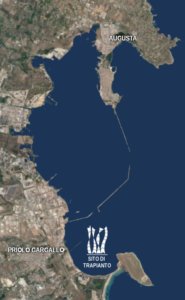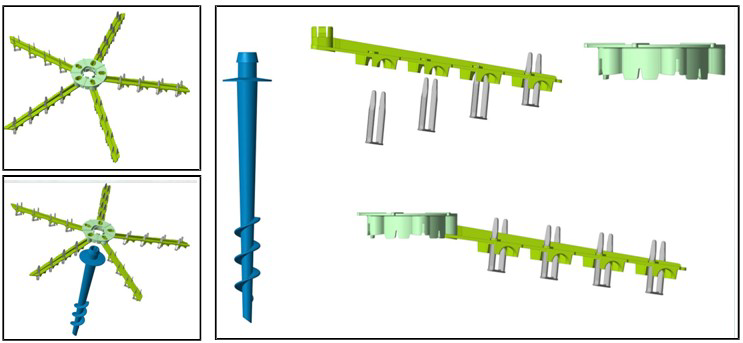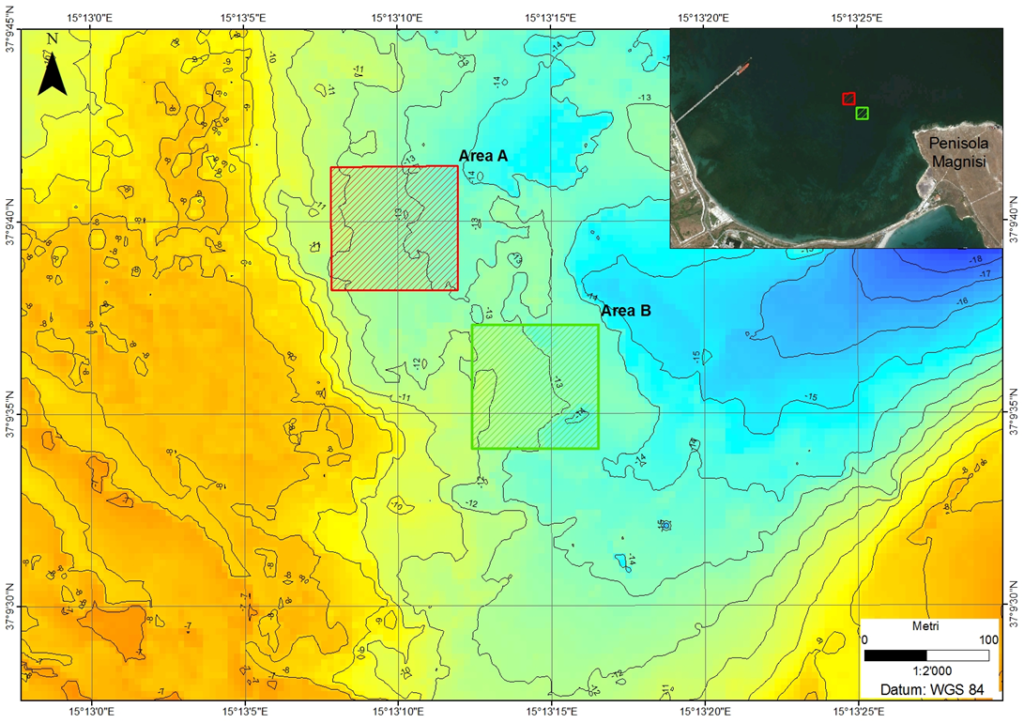Augusta – Priolo Gargallo
Context
The restoring with Posidonia oceanica was carried out from 2012 to 2015 as part of the Research and Training Project PON01_03112 “Advanced eco-sustainable technologies aimed at the reclaim of degraded coastal marine areas (TETIDE)” (PON R&C 2007-2013, www.progettotetide.it).
The intervention area is located in the Augusta bay, within the polluted Site of National Importance (SIN) of Priolo Gargallo (SR), included in the coastal strip affected by the activities of the Priolo-Melilli-Augusta Petrochemical Pole. In 1990, the site was declared “Area of high risk of environmental crisis” by the Ministry of the Environment. In particular, the seabed of the sea in front of the SIN today shows evident signs of the environmental impact caused by decades of uncontrolled industrial discharges, which have resulted in the disappearance of about 1,200 hectares of P. oceanica. Taking into account the goods and services provided by the P. oceanica prairie in economic terms, damage was estimated at about 2 billion euros per year (Vassallo et al., 2013). The transplant was carried out on dead mattes on a total surface of 2,500 m2 at a depth of about 12 m in the “Seno di Priolo” location (Fig.1), in areas identified as suitable for transplantation.
Transplant technique
This technique involves the use of an innovative device (patent by Biosurvey Srl, Spin-off of the University of Palermo and IDEA Srl) consisting of a system made of biodegradable plastic (MaterBi) for a rapid and efficient positioning of Posidonia oceanica cuttings on the seabed. This system consists of a radial structure, which can be anchored to the bottom by means of a quick-fixing stake (Figure 2). The radial structure is modular with a central knot, locked to the stake by means of a bayonet coupling system, and five arms on which there are a variable number of supports (tweezers) for the optimal fixing of the cuttings (Figure 2).
Taking into account that P. oceanica has rhizomes with an elliptical section, the tweezers have been configured in an oval shape to obtain a better insertion of the rhizome. The cuttings taken for transplantation are inserted into the tweezers, characterized by a profile suitable for the plant to be transplanted and by appropriately shaped anti-tear strips.
The radial structure is prepared out of the water by locking the arms with the cuttings at the central node. The diver, after placing the tip on the bottom, using a special screwdriver (manual or compressed air) introduces the whole stake into the substrate. Subsequently, the previously prepared radial structure is locked to the head of the stake by means of a bayonet-hooked system. The density and shape of the implant arms depend on the specific condition of the seabed.
First monitoring of the transplant in 2014
At the end of the transplantation activities (which took place in two stages, in June 2014 and November-December 2014), the monitoring activities began, which continued until November 2015 as part of the TETIDE Project, and then until December 2016, as part of the PON03PE_00203 – MARINE HAZARD Project, for a total duration of approximately two years. Non-destructive monitoring in the transplant areas was performed four times a year and the following measurements were carried out in immersion:
- persistence of anchoring modules
- number of bundles per module
- mortality and detachment of cuttings
- rooting of the cuttings
- growth of plagiotropic rhizomes (this parameter acquired annually)
- longer leaf length
At the same time and with the same time intervals in two areas of the donor prairie the density of the bundles and the leaf length were measured in permanent squares of 0.5×0.5 meters. In Fig. 3 the temporal phases of transplantation and subsequent monitoring are schematically represented.

Figure 3 – Timeline of the monitoring campaigns carried out on the Priolo Gargallo site after the transplantation
Monitoring activities during LIFE SEPOSSO project
Between 9 – 13 July 2018 the SEPOSSO Partnership participated in the field activities on the Priolo/Augusta transplant site. Specifically, 6 divers from the University of Palermo, the University of Rome “Tor Vergata”, ISPRA, ARPAT, AdSPMTS and SETIN S.r.l. participated in the activities. As part of these activities, a pre-dive briefing was carried out, where the University of Palermo, based on the experience gained in previous
phases of transplantation and site monitoring, coordinated the activities.
Non-destructive monitoring was carried out on all the monitoring stations in the Priolo site. Two monitoring campaigns have been planned (Summer 2018 and Summer 2019). The first campaign was carried out following the sharing activities between the Partnership. The following activities were carried out, coinciding with those carried out in previous years:
- persistence of anchoring modules
- number of bundles per module
- mortality and detachment of cuttings
- rooting of the cuttings
- growth of plagiotropic rhizomes
- length of the longest leaf and determination of the state of the apex
Footage acquired on Area “A” in 2018



